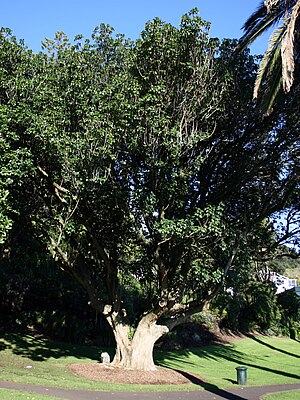Vitex lucens
| Vitex lucens | ||||||||||||
|---|---|---|---|---|---|---|---|---|---|---|---|---|

Puriri |
||||||||||||
| Systematics | ||||||||||||
|
||||||||||||
| Scientific name | ||||||||||||
| Vitex lucens | ||||||||||||
| Kirk |
The Vitex lucens ( Puriri ) is a tree of the species of the mint family (Lamiaceae). This species is found only in New Zealand .
Puriri trees can get very old. One specimen whose cavity was used as a sacred grave by the Māori tribe is estimated to be over 2000 years old and can be found in the Hukutaia Domain , near Opotiki in the Bay of Plenty .
features
The Puriri is an evergreen tree that can grow to heights of up to 20 meters and its uneven trunk is usually up to 1.5 meters in diameter. The treetop develops massively far away. The thin bark is usually smooth and light brown, but it can also be flaky.
The leaves are fingered in three to five parts, the leaflets are elliptical in shape. The color of the leaves is dark green with a glossy surface. They are between 5 and 12 inches long.
The small zymous inflorescence consists of ten to fifteen flowers. The pink to red flowers are 2.5 to 4 centimeters long. Although the tree bears flowers all year round, it has its main flowering time in the winter months of June to October. The unisexual flowers are mainly pollinated by the Tui and the New Zealand Bellbird ( ornithophilia ). When ripe, the light red, round and fleshy stone fruits have a diameter of about 2 centimeters and serve as food for birds all year round ( ornithochory ).
The number of chromosomes is 2n = 64.
distribution
The range of the Puriri extends over the coastal and lowland regions of the North Island of New Zealand, from the extreme north to something towards the center of the island. In settlement heights of up to a maximum of 800 meters, it prefers fertile soils. As a forest tree, the Puriri can hardly be found anymore, but is still planted as an ornamental and street tree.
With the intensification of agriculture, the tree population of the Puriri also declined. It is a little more common where there is little agriculture, especially in the northern regions. The Puriri is not currently classified as an endangered species, but its decline in cultivated landscapes is noteworthy. A slight recovery can be expected in forests. It is not yet clear to what extent the widespread distribution of the possum ( Trichosurus vulpecula ) may have an impact on the health of the tree.
Systematics
Vitex lucens was described by Thomas Kirk in 1897 .
use
The wood of the Puriri is heavy, extremely hard and has a high density of 900 kg / m 3 . Thanks to its longevity, the Māori used the tree's wood to make tools and weapons. Since the wood could easily sink to the bottom in the water, they also used it to build eel traps.
Despite its uneven grain, European immigrants used wood in railway construction for sleepers, posts and masts in the early days. In early reports it was described that there were naturally grown trees with trunks 4.5 to 9 meters in length, which were used for the production of furniture or even as a veneer for inlays . The appearance was compared to the quality of American or Italian walnut wood .
Today the wood is rarely used. Due to the caterpillar infestation of the moth Charagia virescens , it is very often fraught with errors, which limits its use accordingly.
Web links
- Puriri (Vitex lucens). National Association of Woodworkers New Zealand,accessed December 20, 2019.
Individual evidence
- ↑ Hukutaia Domain . Opotiki District Council , archived from the original on March 31, 2014 ; accessed on January 20, 2016 (English, original website no longer available).
- ↑ a b c d Alec Lindsay Poole : Puriri ( Vitex lucens ). In: Te Ara - the Encyclopedia of New Zealand . Ministry for Culture & Heritage , accessed June 29, 2010 .
- ↑ a b c Puriri ( Vitex lucens ). (PDF; 220 kB) National Association of Woodworkers New Zealand , archived from the original on July 5, 2011 ; accessed on May 22, 2019 (English, original website no longer available).
- ↑ a b P.J. Barrell, RC Gardner, TE Richardson : Molecular markers and experimental pollinations reveal self-fertility and high levels of natural inbreeding in the New Zealand endemic tree Vitex lucens ( puriri ) . In: New Zealand Journal of Botany . tape 35 , no. 4 , 1997, p. 535-543 , doi : 10.1080 / 0028825X.1987.10410177 (English).
- ^ Vitex lucens at Tropicos.org. In: IPCN Chromosome Reports . Missouri Botanical Garden, St. Louis
- ↑ The health of Puriri ( Vitex lucens ). (PDF; 507 kB) Department of Conservation , accessed on July 31, 2010 (English).
